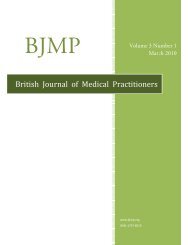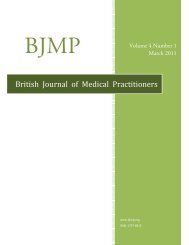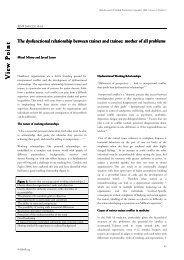R esearch A rticle - British Journal of Medical Practitioners
R esearch A rticle - British Journal of Medical Practitioners
R esearch A rticle - British Journal of Medical Practitioners
You also want an ePaper? Increase the reach of your titles
YUMPU automatically turns print PDFs into web optimized ePapers that Google loves.
<strong>British</strong> <strong>Journal</strong> <strong>of</strong> <strong>Medical</strong> <strong>Practitioners</strong>, March 2013, Volume 6, Number 1<br />
implementation group. Differences in baseline and at 9 month<br />
re audit methadone dose and heroin use were tabulated for each<br />
group. Mann-Whitney U-tests compared any differences<br />
between the two groups. Differences within each group were<br />
also compared using the Wilcoxon signed ranks test.<br />
Results<br />
The implementation service managed 534 patients, <strong>of</strong> whom<br />
130 (24%) were initially identified as non-responders, reporting<br />
heroin use on 8 or more days in the previous month at their last<br />
TOP interview. At the TAU service there were 485 patients, <strong>of</strong><br />
whom 112 (23%) were identified as non-responders. Of the<br />
242 non-responders in total, 67 (28%) were new to treatment,<br />
and were excluded. This is illustrated in the flowchart 2.<br />
Flowchart 2: Sample Algorithm<br />
receive their prescription renewal after attending, some patients<br />
chose to go without methadone and make contact a few days<br />
later, rather than attend an appointment. Among those who did<br />
attend, there was frequently resistance to increasing their<br />
methadone dose, and anger at the suggestion that medication<br />
administration should be supervised. Word <strong>of</strong> mouth spread<br />
through the service that doctors were proposing dose increases<br />
and more supervision. This increased resistance among patients,<br />
and appears to have generated some resistance among<br />
keyworkers, some <strong>of</strong> whom saw their role as advocates for the<br />
patients.<br />
Table 1 Pr<strong>of</strong>ile <strong>of</strong> non-responders and their treatment at<br />
baseline<br />
Implementation TAU<br />
Total<br />
N 104 71 175<br />
Mean age in years (min, max) 42 (25,66)<br />
43<br />
(23,63)<br />
42<br />
(23,66)<br />
Male (%) 65 (63%) 48 (68%)<br />
113<br />
(65%)<br />
Mean IMD Score (SD) 62 (14.6) 62 (14.7) 62 (14.7)<br />
Mean methadone dose in mg<br />
(SD)<br />
Median Months in this Rx<br />
episode (IQR)<br />
60 (17.8) 60 (21.3) 60 (20.3)<br />
18 (20) 17 (10) 18 (14)<br />
Any supervised doses 56 (54%)<br />
Last TOPS > 6/12 ago 15 (15%)<br />
22<br />
(31%)*<br />
29<br />
(42%)**<br />
78 (45%)<br />
44 (25%)<br />
Approximately 50% <strong>of</strong> the non-responders in each group<br />
reported daily heroin use at baseline. The two groups <strong>of</strong> nonresponders<br />
did not differ significantly in terms <strong>of</strong> age, sex<br />
distribution, nor on the Index <strong>of</strong> Multiple deprivation scores<br />
(mean <strong>of</strong> 62 reflecting very severe social exclusion across both<br />
groups). Non responders in the implementation service had<br />
been in treatment a median <strong>of</strong> 18 months compared to 17<br />
months for those in treatment as usual. Urine testing was<br />
performed infrequently in both services, but a result was<br />
available from the six months prior to baseline for 133 <strong>of</strong> the<br />
remaining 175 subjects. The urine tests results were broadly<br />
consistent with the patients self-report. Aspects <strong>of</strong> treatment at<br />
the two services differed, as shown in Table 1. At baseline, doses<br />
did not differ significantly, but the treatment as usual group was<br />
significantly less likely to have their methadone administration<br />
supervised, and had less frequent TOP monitoring.<br />
Despite almost all non-responders being booked in for an<br />
appointment and given reminders at the implementation<br />
service, only 47 (45%) <strong>of</strong> the 104 identified attended at least<br />
one medical review. Keyworkers commented that the main<br />
reason for non-attendance was that clients were quite happy<br />
continuing heroin use and did not see stopping as something<br />
they wanted to do. When patients were told they would only<br />
*Pearson Chi square 9.995, df=2, p=0.007 **Mann-Whitney U =2654,<br />
p=0.002<br />
The attempt to implement change in one clinic appears to have<br />
had small effects in increasing average doses there, and having<br />
more patients seen by a doctor. Between baseline and 9 month<br />
re-audit (follow-up), mean methadone doses increased in the<br />
implementation group and fell in the TAU group, as shown in<br />
Table 2. There was a small and statistically significant increase<br />
in methadone dose in the implementation group compared to<br />
the TAU group. The difference in change in methadone dose<br />
between the two groups was statistically significant (Mann-<br />
Whitney U= 2745, p=0.002), but the mean dose increase (3mg)<br />
in the implementation group was small. In the 6 months prior<br />
to the collection <strong>of</strong> follow-up data, medical reviews in both<br />
services were infrequent; 36% <strong>of</strong> patients in the implementation<br />
group and 66% <strong>of</strong> patients in the TAU group had not seen a<br />
doctor in their OST service (Chi square =13.38, df=1,<br />
p=0.001).<br />
In both groups, the reductions in heroin use over time were<br />
statistically significant (Wilcoxon signed ranks test p =







